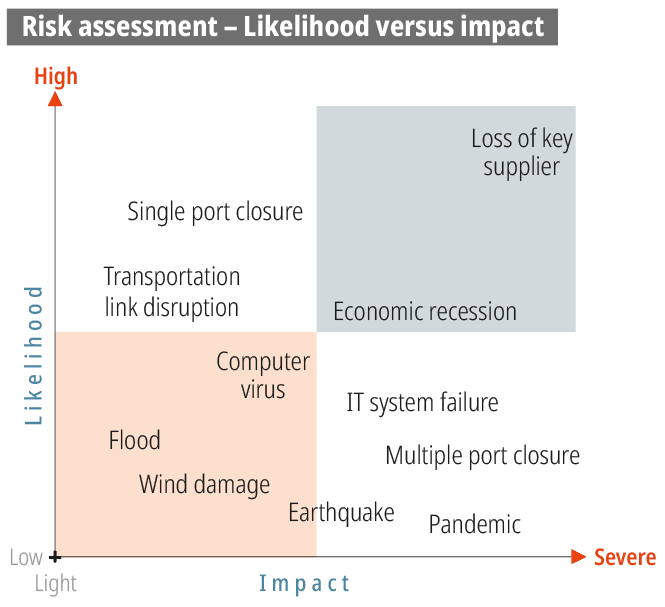Issue
The COVID-19 pandemic is not the first shock that has raised concerns on the resilience of global supply chains. Natural disasters and meteorogical events, trade and political tensions, as well as exposure to cyberattacks have increased in recent years and can impact global supply chains to different degrees. It is important that risk management strategies take such shocks into account and assess how likely they are to occur. These assessments should be reviewed on a regular basis.
Some of the risks that could severely impact global supply chains include the following:
- Natural disasters: Earthquakes, tsunamis, hurricanes, floods, etc., can significantly halt production within the domestic economy or, when such disasters occur in a third country, affect the international supply of inputs. These risks generally affect a specific area, with all activities impacted. In general, such events cannot be prevented from occurring, so it is important that risk policies focus on immediate response strategies.
- Accidents: Accidents such as fires, explosions, and contamination are specific to a given location of production. Unlike natural disasters, safety regulations and government policies can mitigate their occurrence. Accidents represent a global risk when they affect a key resource or impact a concentrated area of production. Identifying such areas could prevent accidents that create global supply chain disruptions.
- Intentional disruptions: Terrorist attacks, sabotage, or actions undertaken by activists can disrupt supply chains. These actions generally target companies or locations that are of strategic importance or which can potentially create widespread disruption leading to global risks. Government action and prevention can reduce such risks.
- International crises with contagion effects: COVID-19 illustrates the extreme case of a crisis that starts in one country and rapidly spreads worldwide (in this case, a virus contagion leading to a pandemic). Financial crises are another example with deep and long-lasting consequences as illustrated by the 2007-2008 financial crisis. Their prevention requires international cooperation in addition to relevant actions by governments at the national level.
Risks are generally categorised according to a 2 by 2 matrix (see figure below) based on their likelihood and impact. Although governments should focus on preventing severe risks that have a high likelihood of occurrence, COVID-19 has demonstrated the need to develop policy measures to confront severe risks with a low likelihood of occurrence given that firms are less likely to invest in the requisite risk management strategies.
Policy action
- Develop risk management strategies at the national level for essential supply chains. These should include a review of potential risks and identifying the priorities in terms of government action. Strategies should not only cover international supply but look at the whole value chain.
- Identify and agree on a diverse set of vulnerability indicators that encompass a wide range of potential risks.
- Identify relevant government bodies. A specific government agency can be in charge of overall risk management, or a specific administration can deal with supply chain risks. Coordination across different agencies and administrations is key to implementing efficient risk management strategies.
- Review regulations regularly in order to prevent risks. While some risks are unavoidable, others can be prevented or reduced through government action (e.g. safety regulations, enforcement of compliance with environmental standards).
 |
| Source: Author’s elaboration |
Related tools & publications
- Australian Productivity Commission (2021), “Vulnerable Supply Chains”, Interim Report, Canberra.
- Global Affairs Canada (2020), “Vulnerability of Canadian industries to disruptions in global supply chains”. In Canada’s State of Trade 2020, chapter 3.
- Korniyenko, Y., M. Pinat and B. Dew (2017), “Assessing the Fragility of Global Trade : The Impact of Localized Supply Shocks Using Network Analysis”, IMF Working Papers No. 17/30.
- OECD (2011), “Future Global Shocks: Improving Risk Governance”, OECD Reviews of Risk Management Policies, OECD Publishing, Paris.
- OECD Reviews of risk management strategies
- OECD (2017), Boosting Disaster Prevention through Innovative Risk Governance: Insights from Austria, France and Switzerland, OECD Reviews of Risk Management Policies, OECD Publishing, Paris.
- Sheffi, Y. (2015), The Power of Resilience: How the Best Companies Manage the Unexpected, MIT Press.
|

